Basketball Transition Offense, Fast-Break Offense
By Dr. James Gels, from the Coach’s Clipboard Basketball PlaybookDisclosure: This page contains affiliate links, which means that Coach's Clipboard receives a small commission (at no cost to you) if you make a purchase using these links.

"As coaches we talk about two things: offense and defense. There is a third phase we neglect, which is more important. It's conversion from offense to defense and defense to offense." — Bobby Knight
"Transition" refers to the process of changing from defense to offense (transition offense), or offense to defense (transition defense). Your transition offense can be a slow, walk-it-up-floor transition, an aggressive fast break transition, or something in between. You have to decide which is best for your team and personnel. Do you really want an up-tempo fast game, especially if you have a strong half-court game with good post players, or if your guards are inexperienced, not particularly quick, and have trouble controlling the ball?
On the other hand, if your team is quick, with good experienced ball handlers, an aggressive up-tempo style has advantages.
Advantages
1. The fast break can produce easy scores.2. Pushing the ball up the floor quickly puts pressure on the opponent, and they will worry about getting back on defense. This may cause them to be less aggressive going for offensive rebounds, and may keep their point guard from penetrating (thinking he has to stay back to prevent the fast break).
3. An aggressive team attitude on offense will often carry over to your defense and rebounding.
4. An up-tempo game will favor the team that is well-conditioned. A poorly conditioned team will "run out of gas" by the fourth quarter.
5. The fast-break will often break the opponent's press defense.
6. A team that plays up-tempo will usually use more of its bench players, with frequent substitutions. This often creates good team harmony with many players getting playing time. An up-tempo game will favor the team with a "deep bench", with many good substitute players.
7. The players and fans enjoy a well-played up-tempo game.
8. Getting the ball up the floor quickly before the defense is set is a good tactic against zone defenses.
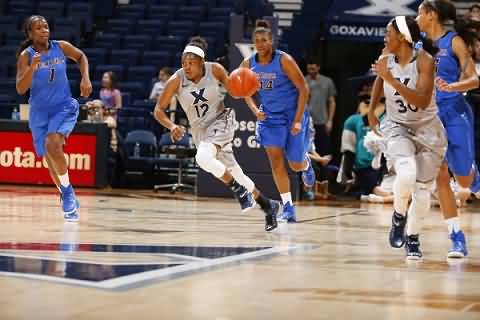
Advance quickly up the court
Transition Offensive Basics
The most important rule to ingrain in your players' minds is to always maintain control. You don't want your fast-break to lead to turnovers and missed opportunities to score. Players have to learn to recognize when to push the break, and when to slow down. They must learn not to force bad passes. Some teams like to push the break every opportunity they can (after a steal, defensive rebound, an opponent's score, etc). Some teams only push it up after a steal or a score, or only certain times of the game.Young players must be taught how to transition from defense to offense. Kids must be taught that when a player gets a defensive rebound, the rebounder should immediately look to pass to a guard, a good ball-handler, to get the ball up the court, even if you are playing a slow-down game.
Teach your guards that on every defensive rebound, they must move into a position quickly where the rebounder can pass to them. Coaches often assume kids know this, but like every other fundamental in the game, it must be taught. Rebounders should be taught to take care of the ball after a defensive rebound and make a clean, simple pass to a guard. Often I see a player work hard for the rebound, only to lose it with a bad outlet pass. Teach your players that an opponent is often lurking around to steal the outlet pass.
Some coaches like to assign the same person (usually a post player with good passing skills) to be the inbounds passer each time a basket is made, or when the ball is taken out-of-bounds. The post player who does not get the rebound should sprint up the floor to the basket ("rim run"). This could result in a long pass and lay-up if the post player beats the defense up the floor.
Running the primary fast break
There are different ways of running the transition offense, but most methods use the idea of filling three lanes coming up the floor, a "trailer", and a "prevent" person (diagram A). The guards, and small forward should run the three lanes. One lane is straight up the middle of the floor, and the other lanes are wide along each sideline.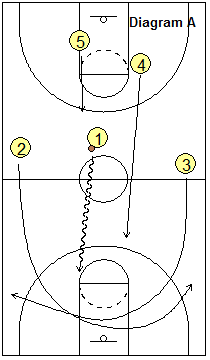
Some coaches feel that it doesn't matter which player is in which lane, but just fill each lane position as quickly as possible and "go!". In the event that two players run the same sideline - the first player up the court back-screens for the second player and then pops to that wing, while the second player cuts around the screen to the hoop, and then out to the opposite wing.
Other coaches teach that the outlet pass always goes to the point guard (the team's best ball handler) in the center, and the outside lanes, trailer and prevent position are assigned to specific players, so each one knows his role.
We outlet pass to our point guard on the ball-side sideline-wing area. Even after we get a steal, we want our point guard to get the first pass along the ball-side sideline. Often after a steal, a bad pass is made into traffic and the opponent gets the ball right back. Teach your point guard to be alert and get to the correct sideline for that pass.
After receiving the pass, the point guard speed-dribbles up the center lane. If the break doesn't develop, then bring it up slowly and avoid the turnover that can happen by forcing things that aren't there. Another rule: the rebounder is the last to come up the floor.
When running the primary break, preferably the ball will be in the center lane, although the break can be run from the wing and can be run with only two lanes filled (as after a quick mid-court steal). The center person should dribble the ball all the way to the free throw lane, and should not make any unnecessary passes prior to that point.
The two outside lanes should cut at 45 degrees to the hoop for a pass from the point, and a lay-up. If the point guard shoots the free throw jumper, the wings should crash the boards for the rebound. If neither happens, the wings should cross under the basket and fill the opposite corner or wing, and the point guard should move to the right side of the free throw circle.
Next the "trailer" should cut through the lane, expecting the pass. The "prevent" player should come up the floor making sure no opponents are behind him. He prevents the opponent from scoring should they steal or intercept the ball. If nothing develops from the break, the team then flows into its usual half-court offensive set.
Starting the break
Coaches differ on how to start the break off a defensive rebound. Some prefer the outlet pass to go to a guard out on the wing (free throw line extended). This guard can either pass to the other guard who is filling the center lane, or dribble quickly and fill the center lane himself.Other coaches teach getting the outlet pass to the point guard in the center of the floor just above the arc. If you can get this pass through, this is certainly the fastest way to get the break going, and avoids a pass to the wing, and a centering pass. It also gets the ball into the hands of your best ball-handler. The point guard should meet the pass, and start the speed-dribble up the floor, while the other guard and small forward fill the outside lanes.
A successful fast break depends on:
1. Getting the defensive rebound.2. A good, quick outlet pass.
3. Filling the lanes.
4. Maintaining control. "Be quick, but never hurry."
5. Recognition. Don't force the break or pass if it is not there.
Coach Jamie Dixon discusses transiition offense - from his DVD:
Open Practice: Transition into the 4-Out 1-In Motion Offense & Special Situations:
Open Practice: Transition into the 4-Out 1-In Motion Offense & Special Situations:
Special Situations:
2-on-1 Break
If you are in a 2-on-1 situation when attacking the hoop, your first thought should be to score or get fouled. Attack the hoop at an angle along the lane line (see diagram below). Your teammate should be at the opposite low block looking for the pass or rebound. If the defender comes up, or sets to take the charge, pull up and pass to your teammate. See the 2-on-1 drill.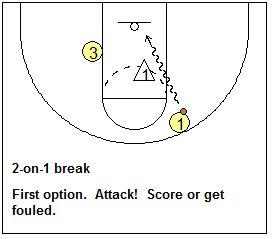
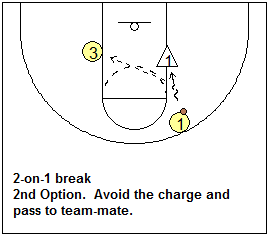
3-on-2 Break
In this situation, there are two defenders back and the offense has the middle and two outside lanes filled. Usually, one defender will stop the ball at the top, and one stays inside down low. The point guard should not penetrate beyond the free-throw line or elbow. He/she should look for a wing cutting to the hoop and pass to the open wing, who then has a 2-on-1 situation with the low defender and should either score or get fouled as the first option (diagram A below).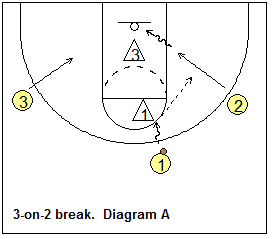
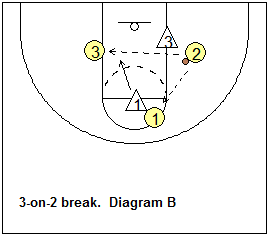
Over-passing in transition sometimes results in a turnover and a missed opportunity, and allows defenders time to get back. If the defender sets to take the charge, dish either to the teammate on the opposite block, or back to the point guard for the shot from the elbow (diagram B).
Drills
Here are several transition offense drills.- 2-on-1 Continuous Transition Drill
- Transition Offense Drills
- 4 on 4 Transition
- Pitch 'n Fire
- Rebound-Outlet-Break Drill
- 11-Man Drill
- 4-on-4-on-4 Drill
Secondary Fast Break
When the primary fast break is not possible, run a secondary break. Having a secondary break is helpful in getting quick baskets in transition, before the defense can get down the floor. Also a good secondary break can flow directly into your half-court offense. A good use of the secondary break is after the opponent scores. We like the secondary "numbered" break (see below). We inbound the ball quickly and get it moving up the floor. See these articles:Quick Transition and "Early" Offense
See these pages on how to transition quickly into an early offense:- Pace and Space Offense
- Pistol Actions - early offense
- Duke Transition and Early Motion Offense Options
- Fred Hoiberg's Transition to Early Offense
- Grinnell Offense
- Off the Break Pick and Roll Plays